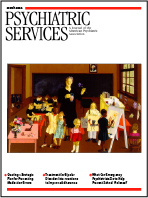Pentagon Employees After September 11, 2001
To the Editor: In the October 2003 issue of Psychiatric Services, Dr. Grieger and his colleagues (1) reported the results of a study that showed a 14 percent prevalence of "probable" posttraumatic stress disorder (PTSD) among survivors of the September 11, 2001, attack on the Pentagon. The study had serious methodologic problems, quite apart from the very low survey response rate (11 percent). The authors provided insufficient detail of the scoring methods and distribution of responses for the Impact of Events Scale-Revised (IES-R) to support their conclusions about the prevalence rate. There are five possible responses to the instrument's 22 questions about symptoms: not at all, a little bit, moderately, quite a bit, and extremely (2). Dr. Grieger and his colleagues apparently scored any affirmative response as a symptom endorsement, meaning that even the response of "a little bit" was counted as positive. Thus, if participants responded in this way to one question about intrusive thoughts, three questions about avoidance symptoms, and two questions about hyperarousal symptoms, they would have screened positive for "probable PTSD."
Although it can be argued that this approach follows the basics of DSM-IV criteria, it also means that persons with total IES-R scores as low as 6 could be included in the "probable PTSD" category. No published studies provide support for the validity of this approach, and the approach is inconsistent with scoring methods established for the original 15-item IES or for related instruments such as the PTSD Checklist (2,3). It is also highly unlikely that a person whose responses reflected this minimal level of symptoms would meet DSM-IV PTSD criterion F—clinically significant distress or functional impairment.
Although the original IES and the IES-R differ in response formats and scoring, data from one of the coauthor's own studies (4) provide some idea of the degree to which PTSD is likely to have been overestimated in the Pentagon sample. An analysis of data from motor vehicle accident victims indicated that an IES cutoff score of 19 had only a 38 percent positive predictive value in a population with a 15 percent prevalence of PTSD. When the IES cutoff score was lowered to 8.5 the positive predictive value fell to 25 percent. In other words, of the 11 Pentagon employees identified by Dr. Grieger and colleagues as having "probable PTSD," it is unlikely that more than two or three of them, or 3 to 4 percent of the total sample, actually had the disorder.
There are similar problems with the predictive value for the single item about alcohol—"using alcohol more than you meant to." On the basis of the probable sensitivity and specificity of this question (5), and the low expected prevalence of alcohol use disorders among Pentagon employees, at most only one or two of the ten respondents who answered this question affirmatively had an alcohol problem.
In summary, the study by Dr. Grieger and his colleagues parallels telephone surveys in New York, Washington, and other parts of the country that showed relatively high levels of general distress after September 11. However, it does not provide an indication of the prevalence of probable PTSD or alcohol misuse among persons exposed to the Pentagon attack. At best it measures "subthreshold" PTSD symptoms in a small sample of Pentagon employees.
The authors are affiliated with the Walter Reed Army Institute of Research of the Medical Research and Materiel Command in Silver Spring, Maryland.
1. Grieger TA, Fullerton CS, Ursano RJ: Posttraumatic stress disorder, alcohol use, and perceived safety after the terrorist attack on the Pentagon. Psychiatric Services 54:1380–1382, 2003Link, Google Scholar
2. Weiss DS, Marmar CR: The Impact of Events Scale-Revised, in Assessing Psychological Trauma and PTSD: A Practitioners' Handbook. Edited by Wilson JP, Keane TM. New York, Guilford, 1997Google Scholar
3. Creamer M, Bell R, Failla S: Psychometric properties of the Impact of Event Scale-Revised. Behavior Research and Therapy 41:1489–1496, 2003Crossref, Medline, Google Scholar
4. Fullerton CL, Ursano RJ, Epstein RS, et al: Measurement of posttraumatic stress disorder in community samples. Nordic Journal of Psychiatry 54:5–12, 2000Crossref, Google Scholar
5. Brown RL, Leonard T, Saunders LA, et al: A two-item conjoint screen for alcohol and other drug problems. Journal of the American Board of Family Practitioners 14:95–106, 2001Medline, Google Scholar



